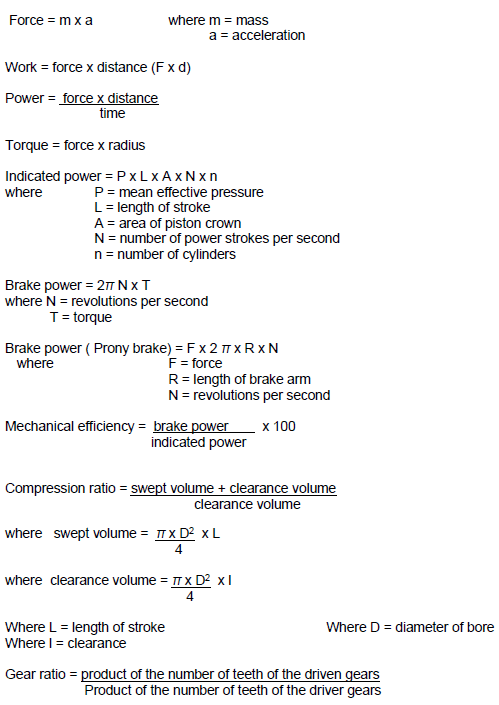Mechanical Technology: Automotive Questions - Grade 12 September 2021 Preparatory Exams
Share via Whatsapp Join our WhatsApp Group Join our Telegram GroupINSTRUCTIONS AND INFORMATION
- Write your NAME and SURNAME on the ANSWER BOOK.
- Read ALL the questions carefully.
- Answer ALL the questions.
- Number the answers correctly according to the numbering system used in this question paper.
- Start EACH question on a NEW page.
- Show ALL calculations and units. Round off final answers to TWO decimal places.
- Candidates may use non-programmable scientific calculators and drawing instruments.
- The value of gravitational force should be taken as 10 m.s-2.
- All dimensions are in millimetres, unless stated otherwise in the question.
- A formula sheet is attached to the question paper.
- Write neatly and legibly.
- Use the criteria below to assist you in managing your time.
QUESTION | CONTENT | MARKS | TIME IN MINUTES |
GENERIC | |||
1 | Multiple-choice questions | 6 | 6 |
2 | Safety | 10 | 10 |
3 | Materials | 14 | 14 |
SPECIFIC | |||
4 | Multiple choice questions | 14 | 10 |
5 | Tools and Equipment | 23 | 20 |
6 | Engines | 28 | 25 |
7 | Forces | 32 | 25 |
8 | Maintenance | 23 | 20 |
9 | Systems and Control (Automatic Gearbox) | 18 | 20 |
10 | Systems and Control (Axles, Steering Geometry) | 32 | 30 |
TOTAL: | 200 | 180 | |
QUESTIONS
QUESTION 1: MULTIPLE-CHOICE QUESTIONS (GENERIC) (COMPULSORY)
Various options are provided as possible answers to the following questions. Choose the correct answer and write only the letter (A–D) next to the question numbers (1.1–1.6) in the ANSWER BOOK, for example 1.7 A.
1.1 Which ONE of the following safety procedures is applicable to the maintenance/operation of a hydraulic press?
- Do not apply a wrench to revolving work.
- Guards could be removed when pressing soft material.
- Pressure gauges must be tested regularly and adjusted or replaced if any malfunctioning occurs.
- Use the machine table as an anvil. (1)
1.2 What is the best way of dealing with a hazard to ensure others are not put at risk?
- Remove it immediately
- Leave it for the supervisor to sort out
- Not placing a barrier tape around it
- Display a notice or warning sign (1)
1.3 Which of the following is a safety precaution related to a work bench?
- The tool rest must not be more than 3 mm from the grinding wheel.
- Make sure the chuck is correctly tightened.
- Stand on the side when switching on the machine.
- Keep rolling stock or items away from the bench end. (1)
1.4 What is the colour of an acetylene cylinder?
- Maroon
- Grey
- Green
- Black (1)
1.5 Starting devices on machinery are normally … in colour.
- red
- green
- black
- orange (1)
1.6 ONE of the following is NOT a safety device used in conjunction with guillotines.
- Self-adjusting guard
- Current scale
- Automatic sweep-away
- Electronic presence detection sensor (1)
[6]
QUESTION 2: SAFETY (GENERIC)
2.1 State TWO safety precautions that should be observed before pressing a bearing from a shaft using a hydraulic press. (2)
2.2 Sketch and label a product layout. (2)
2.3 What is the reason for mounting a Perspex shield on a bench grinding machine? (1)
2.4 Study both pictures in FIGURE 2.4 and answer the questions that follow.
FIGURE 2.4
2.4.1 Name the machine shown in FIGURE 2.4. (1)
2.4.2 Identify the parts labelled A to D (4)
[10]
QUESTION 3: MATERIALS (GENERIC)
3.1 Explain the term heat treatment. (2)
3.2 Tabulate the following heat treatment processes and identify ONE PROPERTY of each.
| PROCESS | PROPERTY | |
| 3.2.1 | Hardening | |
| 3.2.2 | Tempering | |
| 3.2.3 | Annealing | |
| 3.2.4 | Normalising |
3.2.1 Hardening
3.2.2 Tempering
3.2.3 Annealing
3.2.4 Normalising (4 x 1) (4)
3.3 Describe the specific purpose for case-hardening on mild steel. (2)
3.4 What effect does carbon have when hardening steel? (2)
3.5 Name TWO workshop tests which are used to make a distinction between materials. (2)
3.6 State TWO reasons for annealing as a heat-treatment process. (2)
[14]
QUESTION 4: MULTIPLE-CHOICE QUESTIONS (SPECIFIC)
Various options are provided as possible answers to the following questions. Choose the answer and write only the letter (A–D) next to the question numbers (4.1–4.14) in the ANSWER BOOK, for example 4.15 A.
4.1 Which ONE of the following safety rules does not relate to an emission gas analyser?
- The hose connection must be straight and the valve on the condenser must be closed.
- You can only change the filter paper when it turns red.
- The vehicle under testing must not have leakage in the exhaust and vacuum system.
- Condensate must be blown out of the hoses and pickup probe regularly using compressed air. (1)
4.2 Which ONE of the following tests indicates the condition of the valves in the cylinder head of an engine?
- Fuel test
- Cooling system pressure test
- Cylinder leakage test
- Gas analyser (1)
4.3 In a four-cylinder engine, which of the firing order displayed below is NOT applicable?
- 1, 3, 4, 2
- 1, 2, 4, 3
- 1, 2, 3, 4
- 1, 3, 2, 4 (1)
4.4 What is the unit of torque?
- N.m
- N/m2
- N/m
- N/m3 (1)
4.5 When carrying out dynamic balancing, there are a number of factors that must be considered in order to achieve a correct wheel balance. Which of the following is NOT applicable?
- The plane of imbalance
- The speed of the unbalanced forces
- The extent of the unbalanced forces
- The sense of the direction of unbalanced forces (1)
4.6 The … is used to obtain different gear rations between the driving and the driven gear members of an automatic transmission system.
- brake system
- catalytic converter
- epicyclic gear system
- clutch system (1)
4.7 In an air induction system, the regulation of the idle speed by adjusting the air volume allowed to by-pass the closed throttle valve at cold start is caused by the …
- pressure regulator.
- throttle position sensor.
- mass air flow meter.
- idle speed control valve. (1)
4.8 There are different types of Diesel Particulate Filter (DPF) used within the automobile trade to remove soot from the exhaust gases of a diesel engine. Which of the following is NOT applicable in this regard?
- Cordirite wall flow filter
- Silicon carbide wall flow filters
- Ceramic fibre filters
- Fuel filter (1)
4.9 Which of the following methods are commonly used to increase the output frequency of an alternator?
- Increase the turns of wire on the stationary coil
- Increase the magnetic fields
- Increase the rotational frequency at which the magnet rotates
- All of the above. (1)
4.10 If a man raises a bucket of water of mass 6 kg from a 10 m deep well in 30 seconds, what will be the power released?
- 20 W
- 15 W
- 18 W
- 30 W (1)
4.11 The … is an important factor that determines the thermal efficiency of an engine.
- Design of the intake manifold
- Type of mass air flow meter
- Combustion chamber design
- Fuel pump (1)
4.12 Which ONE of the following is an advantage of a variable geometry turbocharger to a non-variable type turbocharger?
- Throttling loss of the waste gate valve
- Higher air-fuel ratio and higher peak torque at low engine speed
- Poor boost
- Higher pressure developed at the exhaust manifold (1)
4.13 What is the gear ratio of a gear train with a driver gear rotating at 300 r/min and the driven gear rotating at 50 r/min?
- 5 : 1
- 6 : 1
- 3 : 5
- 2 : 1 (1)
4.14 Which device in the exhaust system converts the toxic gases produced in the combustion chamber of an engine into less harmful gases at the tail pipe?
- Catalytic converter
- Torque converter
- Exhaust manifold
- Exhaust valve seals (1)
[14]
QUESTION 5: TOOLS AND EQUIPMENT (SPECIFIC)
5.1 FIGURE 5.1 below shows equipment that is commonly used during maintenance activities in an automotive workshop. Answer the questions that follow.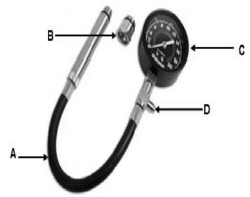
FIGURE 5.1
5.1.1 Identify the equipment in FIGURE 5.1. (1)
5.1.2 Label parts A–D. (4)
5.1.3 What is the purpose of the equipment in FIGURE 5.1? (2)
5.2 What is the function of a cylinder leakage tester? (2)
5.3 In point form, explain the set-up procedure to follow while performing a cylinder leakage test on a car engine. (6)
5.4 Why is it important to analyse the gas emission of an internal combustion engine during the course of maintenance in the workshop? (2)
5.5 What is the purpose of the following wheel alignment equipment?
5.5.1 Bubble gauge (2)
5.5.2 Turntable (3)
5.5.3 Periscopic optical alignment gauge (1)
[23]
QUESTION 6: ENGINES (SPECIFIC)
6.1 The diagram in FIGURE 6.1 below shows a component of an internal combustion engine. Answer the questions that follow.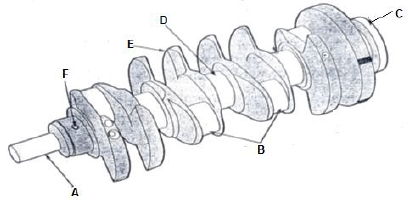
FIGURE 6.1
6.1.1 Identify the diagram in FIGURE 6.1. (1)
6.1.2 Label part A–F. (6)
6.1.3 What is the function of the engine in FIGURE 6.1 above? (2)
6.1.4 What type of cylinder engine is applicable to the engine in figure 6.1? (1)
6.2 The diagram in FIGURE 6.2 below shows a friction face type vibration damper mounted to the front of the crankshaft of an internal combustion engine. Answer the questions that follow.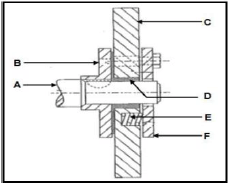
FIGURE 6.2
6.2.1 What is the function of the damper in FIGURE 6.2 above? (2)
6.2.2 Label parts A–F. (6)
6.3 List TWO types of engine cylinder configuration commonly used by automobile industries. (2)
6.4 State TWO factors that determine the firing order of an internal combustion engine. (2)
6.5 Briefly explain the following terms relating to a turbocharger component and operations:
6.5.1 Lag (2)
6.5.2 Boost (2)
6.5.3 Waste gate (2)
[28]
QUESTION 7: FORCES (SPECIFIC)
7.1 Briefly explain the following terms in the cylinder of an internal combustion engine:
7.1.1 Clearance volume (2)
7.1.2 Compression ratio (2)
7.2 Calculate the bore of an engine cylinder that has a compression ratio of 10 : 1 and a stroke of 85 mm if the clearance volume is 60 cm3. (6)
7.3 State THREE methods that can be used to increase the compression ratio of an internal combustion engine. (3)
7.4 If the bore in QUESTION 7.2 is increased by 4,8 mm, while keeping the stroke and the clearance volume constant at 85 mm and 60 cm3 respectively, what will be the new compression ratio of the engine? (5)
7.5 The following data was recorded during the course of carrying out a brake test on a four-stroke four-cylinder petrol engine:
- Brake arm length: 500 mm
- Mass registered on the scale: 35 kg
- Engine speed of rotation: 4 200 r/min
- Mean effective pressure: 1 100 kPa
- Cylinder bore: 95 mm
- Stroke length: 80 mm
Calculate the following:
7.5.1 Indicated power (6)
7.5.2 Torque (3)
7.5.3 Brake power (3)
7.5.4 Mechanical efficiency of the engine (2)
[32]
QUESTION 8: MAINTENANCE (SPECIFIC)
8.1 TABLE 8.1 below shows information regarding the result of the gas analysis of an internal combustion engine.
FAULTS | POSSIBLE CAUSES | CORRECTIVE MEASURE |
High hydrocarbon | 8.1.1 | 8.1.2 |
High carbon monoxide | 8.1.3 | 8.1.4 |
(4)
FIGURE 8.1
8.2 List THREE safety measures that must be followed during compression testing of an internal combustion engine. (3)
8.3 Give THREE manufactural specifications in determining the cause of leakage during a cylinder leakage test. (3)
8.4 Give THREE possible causes of a low oil pressure reading when conducting an oil pressure test on an internal combustion engine. (3)
8.5 Mention FOUR possible components where coolant could leak when using the cooling system pressure tester on a vehicle. (4)
8.6 Name TWO manufactural specifications that are needed when doing a cooling system pressure test. (2)
8.7 State TWO possible causes of each of the following when conducting a fuel pressure test on a vehicle fuel system:
8.7.1 Fuel pressure too low (2)
8.7.2 Fuel pressure too high (2)
[23]
QUESTION 9: SYSTEMS AND CONTROL (AUTOMATIC GEARBOX) (SPECIFIC)
9.1 What was the purpose of introducing automatic gearboxes in vehicles? (2)
9.2 State TWO main differences between an automatic gearbox and a manual gearbox. (2)
9.3 Give TWO major disadvantages of an automatic gearbox. (2)
9.4 What is the function of a torque converter? (2)
9.5 Briefly explain the following states of motion in a torque converter:
9.5.1 Stall speed (3)
9.5.2 Increasing speed (2)
9.6 Give TWO advantages of a torque converter in an automatic transmission system. (2)
9.7 A transmission control unit (TCU) is a device that controls modern electronic automatic transmissions through the use of sensors and an electronic control unit (ECU). State THREE advantages of this device. (3)
[18]
QUESTION 10: SYSTEMS AND CONTROL (AXLES AND STEERING GEOMETRY) (SPECIFIC)
10.1 State TWO main causes of camber wear in the suspension system of a motor vehicle. (2)
10.2 What is the difference between positive and negative camber? (4)
10.3 The diagram in FIGURE 10.3 below shows a wheel alignment angle of a vehicle suspension. Answer the questions that follow.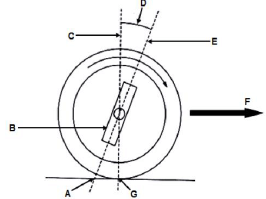
FIGURE 10.3
10.3.1 Identify the type of wheel alignment angle displayed in FIGURE 10.3 above. (2)
10.3.2 Label parts A–G in FIGURE 10.3 above. (7)
10.3.3 Give TWO advantages of the wheel alignment angle in FIGURE 10.3 above. (2)
10.4 State TWO factors to be taken into account before attempting a wheel alignment adjustment. (2)
10.5 What do you understand by the term static balance? (2)
10.6 State TWO pre-checks on wheels before they are balanced (2)
10.7 FIGURE 10.7 below shows the wheel alignment angle of a motor vehicle. Use the diagram to answer the questions that follow.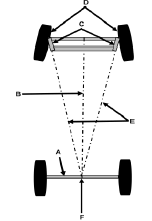
FIGURE 10.7
10.7.1 What type of wheel alignment angle is shown in FIGURE 10.7 above? (1)
10.7.2 Label parts A–F in FIGURE 10.7 above. (6)
10.7.3 What is the purpose of the diagram in FIGURE 10.7 above? (2)
[32]
TOTAL: 200
FORMULA SHEET FOR MECHANICAL TECHNOLOGY (AUTOMOTIVE)
